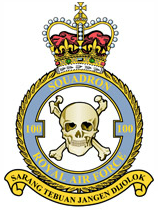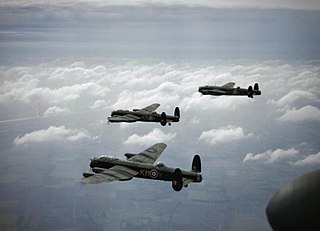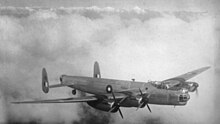
The Bristol Type 156 Beaufighter is a British multi-role aircraft developed during the Second World War by the Bristol Aeroplane Company. It was originally conceived as a heavy fighter variant of the Bristol Beaufort torpedo bomber. The Beaufighter proved to be an effective night fighter, which came into service with the Royal Air Force (RAF) during the Battle of Britain, its large size allowing it to carry heavy armament and early airborne interception radar without major performance penalties.

The Short Stirling was a British four-engined heavy bomber of the Second World War. It has the distinction of being the first four-engined bomber to be introduced into service with the Royal Air Force (RAF).

The Avro Lancaster is a British Second World War heavy bomber. It was designed and manufactured by Avro as a contemporary of the Handley Page Halifax, both bombers having been developed to the same specification, as well as the Short Stirling, all three aircraft being four-engined heavy bombers adopted by the Royal Air Force (RAF) during the same era.

The English Electric Canberra is a British first-generation, jet-powered medium bomber. It was developed by English Electric during the mid- to late 1940s in response to a 1944 Air Ministry requirement for a successor to the wartime de Havilland Mosquito fast bomber. Among the performance requirements for the type was an outstanding high-altitude bombing capability and high speed. These were partly accomplished by making use of newly developed jet-propulsion technology. When the Canberra was introduced to service with the Royal Air Force (RAF), the type's first operator, in May 1951, it became the service's first jet-powered bomber.

The Avro Shackleton is a British long-range maritime patrol aircraft (MPA) which was used by the Royal Air Force (RAF) and the South African Air Force (SAAF). It was developed by Avro from the Avro Lincoln bomber, which itself had been a development of the famous wartime Avro Lancaster bomber.

The Avro 679 Manchester was a British twin-engine heavy bomber developed and manufactured by the Avro aircraft company in the United Kingdom. While not being built in great numbers, it was the forerunner of the famed and vastly more successful four-engined Avro Lancaster, which was one of the most capable strategic bombers of the Second World War.

The Fairey Battle is a British single-engine light bomber that was designed and manufactured by the Fairey Aviation Company. It was developed during the mid-1930s for the Royal Air Force (RAF) as a monoplane successor to the Hawker Hart and Hind biplanes. The Battle was powered by the same high-performance Rolls-Royce Merlin piston engine that powered various contemporary British fighters such as the Hawker Hurricane and Supermarine Spitfire. As the Battle, with its three-man crew and bomb load, was much heavier than the fighters, it was therefore much slower. Though a great improvement over the aircraft that preceded it, its relatively slow speed, limited range and inadequate defensive armament of only two .303 (7.7 mm) machine guns left it highly vulnerable to enemy fighters and anti-aircraft fire.

The Avro Anson is a British twin-engine, multi-role aircraft built by the aircraft manufacturer Avro. Large numbers of the type served in a variety of roles for the Royal Air Force (RAF), Fleet Air Arm (FAA), Royal Canadian Air Force (RCAF), Royal Australian Air Force and numerous other air forces before, during, and after the Second World War.

The Armstrong Whitworth A.W.38 Whitley was a British medium bomber aircraft of the 1930s. It was one of three twin-engined, front line medium bomber types that were in service with the Royal Air Force (RAF) at the outbreak of the Second World War. Alongside the Vickers Wellington and the Handley Page Hampden, the Whitley was developed during the mid-1930s according to Air Ministry Specification B.3/34, which it was subsequently selected to meet. In 1937, the Whitley formally entered into RAF squadron service; it was the first of the three medium bombers to be introduced.

The Handley Page Halifax is a British Royal Air Force (RAF) four-engined heavy bomber of the Second World War. It was developed by Handley Page to the same specification as the contemporary twin-engine Avro Manchester.

The Avro York was a British transport aircraft developed by Avro during the Second World War. The design was derived from the Avro Lancaster heavy bomber, several sections of the York and Lancaster being identical. Due to the importance of Lancaster production, York output proceeded slowly until 1944, after which a higher priority was placed upon transport aircraft.

The Lockheed Hudson is a light bomber and coastal reconnaissance aircraft built by the American Lockheed Aircraft Corporation. It was initially put into service by the Royal Air Force shortly before the outbreak of the Second World War and primarily operated by it thereafter. The Hudson was a military conversion of the Model 14 Super Electra airliner, and was the first significant aircraft construction contract for Lockheed — the initial RAF order for 200 Hudsons far surpassed any previous order the company had received.

The Vickers Warwick was a multi-purpose twin-engined British aircraft developed and operated during the Second World War. In line with the naming convention followed by other RAF heavy bombers of the era, it was named after a British city or town, in this case Warwick. The Warwick was the largest British twin-engined aircraft to see use during the Second World War.

The Avro 691 Lancastrian was a British and Canadian passenger and mail transport aircraft of the 1940s and 1950s developed from the Avro Lancaster heavy bomber. The Lancastrian was basically a modified Lancaster bomber without armour or armament and with the gun turrets replaced by streamlined metal fairings, including a new nose section. The initial batch was converted directly from Lancasters; later batches were new builds.

The Bomb, Medium Capacity, 22,000 lb was a 22,000 lb (10,000 kg) earthquake bomb used by RAF Bomber Command against German targets towards the end of the Second World War. The bomb was originally called Tallboy Large until the term Tallboy got into the press and the code name was replaced by "Grand Slam". The bomb was similar to a large version of the Tallboy bomb but a new design and closer to the size that its inventor, Barnes Wallis, had envisaged when he developed the idea of an earthquake bomb. It was the largest and most powerful conventional aerial bomb used by either side during the war.

No. 1 Group of the Royal Air Force is one of the two operations groups in RAF Air Command. Today, the group is referred to as the Air Combat Group, as it controls the RAF's combat fast-jet aircraft and has airfields in the UK, as well as RAF Support Unit Goose Bay at CFB Goose Bay in Canada. The group headquarters is located alongside Headquarters Air Command at RAF High Wycombe, Buckinghamshire. The other operational group is No. 2 Group RAF.

Number 100 Squadron is a former Royal Air Force squadron. It last operated the British Aerospace Hawk T1, providing 'aggressor' aircraft for air combat training from RAF Leeming in North Yorkshire, UK.

Royal Air Force Hemswell or more simply RAF Hemswell is a former Royal Air Force (RAF) station located 7.8 miles (12.6 km) east of Gainsborough, Lincolnshire, England.

Number 44 (Rhodesia) Squadron was an aviation unit of the Royal Air Force. It was active between 1917 and 1982. For most of its history it served as a heavy bomber squadron.

No. 467 Squadron RAAF was a Royal Australian Air Force bomber squadron, active over North West Europe during World War II. Formed in November 1942 as an Article XV Squadron in Britain, the squadron was notionally an Australian squadron under the command of the Royal Air Force, and consisted of a mixture of personnel from various Commonwealth nations. After becoming operational in early 1943, the squadron flew operations in Occupied Europe until the end of the war flying Avro Lancaster heavy bombers. It was scheduled to deploy to the Far East to take part in further operations against Japan, but the war ended before it could complete its training and the squadron was disbanded in September 1945.
































